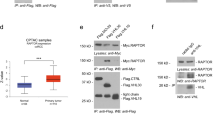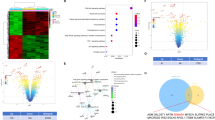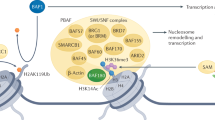Abstract
Functional loss of the von Hippel–Lindau (VHL) tumor suppressor protein (pVHL), which is part of an E3-ubiquitin ligase complex, initiates most inherited and sporadic clear-cell renal cell carcinomas (ccRCC). Genetic inactivation of the TP53 gene in ccRCC is rare, suggesting that an alternate mechanism alleviates the selective pressure for TP53 mutations in ccRCC. Here we use a zebrafish model to describe the functional consequences of pVHL loss on the p53/Mdm2 pathway. We show that p53 is stabilized in the absence of pVHL and becomes hyperstabilized upon DNA damage, which we propose is because of a novel in vivo interaction revealed between human pVHL and a negative regulator of Mdm2, the programmed cell death 5 (PDCD5) protein. PDCD5 is normally localized at the plasma membrane and in the cytoplasm. However, upon hypoxia or loss of pVHL, PDCD5 relocalizes to the nucleus, an event that is coupled to the degradation of Mdm2. Despite the subsequent hyperstabilization and normal transcriptional activity of p53, we find that zebrafish vhl−/− cells are still as highly resistant to DNA damage-induced cell cycle arrest and apoptosis as human ccRCC cells. We suggest this is because of a marked increase in expression of birc5a, the zebrafish homolog of Survivin. Accordingly, when we knock down Survivin in human ccRCC cells we are able to restore caspase activity in response to DNA damage. Taken together, our study describes a new mechanism for p53 stabilization through PDCD5 upon hypoxia or pVHL loss, and reveals new clinical potential for the treatment of pathobiological disorders linked to hypoxic stress.
This is a preview of subscription content, access via your institution
Access options
Subscribe to this journal
Receive 50 print issues and online access
$259.00 per year
only $5.18 per issue
Buy this article
- Purchase on Springer Link
- Instant access to full article PDF
Prices may be subject to local taxes which are calculated during checkout




Similar content being viewed by others
References
Gerlinger M, Rowan AJ, Horswell S, Larkin J, Endesfelder D, Gronroos E et al. Intratumor heterogeneity and branched evolution revealed by multiregion sequencing. N Engl J Med 2012; 366: 883–892.
Sato Y, Yoshizato T, Shiraishi Y, Maekawa S, Okuno Y, Kamura T et al. Integrated molecular analysis of clear-cell renal cell carcinoma. Nat Genet 2013; 45: 860–867.
Cancer Genome Atlas Research Network, Comprehensive molecular characterization of clear cell renal cell carcinoma. Nature 2013; 499: 43–49.
Cohen HT, McGovern FJ . Renal-cell carcinoma. N Engl J Med 2005; 353: 2477–2490.
Motzer RJ, Bander NH, Nanus DM . Renal-cell carcinoma. N Engl J Med 1996; 335: 865–875.
Hsu T . Complex cellular functions of the von Hippel-Lindau tumor suppressor gene: insights from model organisms. Oncogene 2012; 31: 2247–2257.
Semenza GL . Targeting HIF-1 for cancer therapy. Nat Rev Cancer 2003; 3: 721–732.
Kondo K, Klco J, Nakamura E, Lechpammer M, Kaelin WG Jr . Inhibition of HIF is necessary for tumor suppression by the von Hippel-Lindau protein. Cancer Cell 2002; 1: 237–246.
Mack FA, Rathmell WK, Arsham AM, Gnarra J, Keith B, Simon MC . Loss of pVHL is sufficient to cause HIF dysregulation in primary cells but does not promote tumor growth. Cancer Cell 2003; 3: 75–88.
Maranchie JK, Vasselli JR, Riss J, Bonifacino JS, Linehan WM, Klausner RD . The contribution of VHL substrate binding and HIF1-alpha to the phenotype of VHL loss in renal cell carcinoma. Cancer Cell 2002; 1: 247–255.
Horn HF, Vousden KH . Coping with stress: multiple ways to activate p53. Oncogene 2007; 26: 1306–1316.
Kubbutat MH, Jones SN, Vousden KH . Regulation of p53 stability by Mdm2. Nature 1997; 387: 299–303.
Graeber TG, Peterson JF, Tsai M, Monica K, Fornace AJ Jr, Giaccia AJ . Hypoxia induces accumulation of p53 protein, but activation of a G1-phase checkpoint by low-oxygen conditions is independent of p53 status. Mol Cell Biol 1994; 14: 6264–6277.
Alarcon R, Koumenis C, Geyer RK, Maki CG, Giaccia AJ . Hypoxia induces p53 accumulation through MDM2 down-regulation and inhibition of E6-mediated degradation. Cancer Res 1999; 59: 6046–6051.
Sermeus A, Michiels C . Reciprocal influence of the p53 and the hypoxic pathways. Cell Death Dis 2011; 2: e164.
Chen LN, Wang Y, Ma DL, Chen YY . Short interfering RNA against the PDCD5 attenuates cell apoptosis and caspase-3 activity induced by Bax overexpression. Apoptosis 2006; 11: 101–111.
Xu L, Chen Y, Song Q, Xu D, Wang Y, Ma D . PDCD5 interacts with Tip60 and functions as a cooperator in acetyltransferase activity and DNA damage-induced apoptosis. Neoplasia 2009; 11: 345–354.
Xu L, Hu J, Zhao Y, Hu J, Xiao J, Wang Y et al. PDCD5 interacts with p53 and functions as a positive regulator in the p53 pathway. Apoptosis 2012; 17: 1235–1245.
Chen Y, Sun R, Han W, Zhang Y, Song Q, Di C et al. Nuclear translocation of PDCD5 (TFAR19): an early signal for apoptosis? FEBS Lett 2001; 509: 191–196.
Zucchi I, Mento E, Kuznetsov VA, Scotti M, Valsecchi V, Simionati B et al. Gene expression profiles of epithelial cells microscopically isolated from a breast-invasive ductal carcinoma and a nodal metastasis. Proc Natl Acad Sci USA 2004; 101: 18147–18152.
Yang YH, Zhao M, Li WM, Lu YY, Chen YY, Kang B et al. Expression of programmed cell death 5 gene involves in regulation of apoptosis in gastric tumor cells. Apoptosis 2006; 11: 993–1001.
Spinola M, Meyer P, Kammerer S, Falvella FS, Boettger MB, Hoyal CR et al. Association of the PDCD5 locus with lung cancer risk and prognosis in smokers. J Clin Oncol 2006; 24: 1672–1678.
Xiong L, Tan WL, Yu ZC, Wu YD, Huang H, Zhao GZ et al. [Expression of TFAR19(PDCD5) in normal human kidney, renal clear cell carcinoma, normal human bladder and bladder carcinoma]. Nan Fang Yi Ke Da Xue Xue Bao 2006; 26: 805–809.
Tan WL, Xiong L, Zheng SB, Yu ZC, Qi H, Du YJ et al. [Relationship between programmed cell death 5 protein expression and prognosis of renal clear cell carcinoma]. Nan Fang Yi Ke Da Xue Xue Bao 2006; 26: 1316–1318.
Szymanska K, Moore LE, Rothman N, Chow WH, Waldman F, Jaeger E et al. TP53, EGFR, and KRAS mutations in relation to VHL inactivation and lifestyle risk factors in renal-cell carcinoma from central and eastern Europe. Cancer Lett 2010; 293: 92–98.
Albers J, Rajski M, Schonenberger D, Harlander S, Schraml P, von Teichman A et al. Combined mutation of Vhl and Trp53 causes renal cysts and tumours in mice. EMBO Mol Med 2013; 5: 949–964.
Roe JS, Kim H, Lee SM, Kim ST, Cho EJ, Youn HD . p53 stabilization and transactivation by a von Hippel-Lindau protein. Mol Cell 2006; 22: 395–405.
Lane DP . Exploiting the p53 pathway for the diagnosis and therapy of human cancer. Cold Spring Harb Symp Quant Biol 2005; 70: 489–497.
Dong Z, Nishiyama J, Yi X, Venkatachalam MA, Denton M, Gu S et al. Gene promoter of apoptosis inhibitory protein IAP2: identification of enhancer elements and activation by severe hypoxia. Biochem J 2002; 364: 413–421.
Dong Z, Wang JZ, Yu F, Venkatachalam MA . Apoptosis-resistance of hypoxic cells: multiple factors involved and a role for IAP-2. Am J Pathol 2003; 163: 663–671.
Qi H, Ohh M . The von Hippel-Lindau tumor suppressor protein sensitizes renal cell carcinoma cells to tumor necrosis factor-induced cytotoxicity by suppressing the nuclear factor-kappaB-dependent antiapoptotic pathway. Cancer Res 2003; 63: 7076–7080.
MacInnes AW, Amsterdam A, Whittaker CA, Hopkins N, Lees JA . Loss of p53 synthesis in zebrafish tumors with ribosomal protein gene mutations. Proc Natl Acad Sci USA 2008; 105: 10408–10413.
Esteban MA, Tran MG, Harten SK, Hill P, Castellanos MC, Chandra A et al. Regulation of E-cadherin expression by VHL and hypoxia-inducible factor. Cancer Res 2006; 66: 3567–3575.
Kibel A, Iliopoulos O, DeCaprio JA, Kaelin WG Jr . Binding of the von Hippel-Lindau tumor suppressor protein to Elongin B and C. Science 1995; 269: 1444–1446.
Pause A, Lee S, Worrell RA, Chen DY, Burgess WH, Linehan WM et al. The von Hippel-Lindau tumor-suppressor gene product forms a stable complex with human CUL-2, a member of the Cdc53 family of proteins. Proc Natl Acad Sci USA 1997; 94: 2156–2161.
Kamura T, Koepp DM, Conrad MN, Skowyra D, Moreland RJ, Iliopoulos O et al. Rbx1, a component of the VHL tumor suppressor complex and SCF ubiquitin ligase. Science 1999; 284: 657–661.
Tsuchiya H, Iseda T, Hino O . Identification of a novel protein (VBP-1) binding to the von Hippel-Lindau (VHL) tumor suppressor gene product. Cancer Res 1996; 56: 2881–2885.
Lai Y, Song M, Hakala K, Weintraub ST, Shiio Y . Proteomic dissection of the von Hippel-Lindau (VHL) interactome. J Proteome Res 2011; 10: 5175–5182.
Xu L, Hu J, Zhao Y, Xiao J, Wang Y, Ma D et al. PDCD5 interacts with p53 and functions as a positive regulator in the p53 pathway. Apoptosis 2012; 17: 1235–1245.
Sansam CL, Cruz NM, Danielian PS, Amsterdam A, Lau ML, Hopkins N et al. A vertebrate gene, ticrr, is an essential checkpoint and replication regulator. Genes Dev 2010; 24: 183–194.
Cui D, Li L, Lou H, Sun H, Ngai SM, Shao G et al. The ribosomal protein S26 regulates p53 activity in response to DNA damage. Oncogene (e-pub ahead of print 3 June 2013; doi:10.1038/onc.2013.170).
Haase VH, Glickman JN, Socolovsky M, Jaenisch R . Vascular tumors in livers with targeted inactivation of the von Hippel-Lindau tumor suppressor. Proc Natl Acad Sci USA 2001; 98: 1583–1588.
Kleymenova E, Everitt JI, Pluta L, Portis M, Gnarra JR, Walker CL . Susceptibility to vascular neoplasms but no increased susceptibility to renal carcinogenesis in Vhl knockout mice. Carcinogenesis 2004; 25: 309–315.
Rankin EB, Tomaszewski JE, Haase VH . Renal cyst development in mice with conditional inactivation of the von Hippel-Lindau tumor suppressor. Cancer Res 2006; 66: 2576–2583.
Fu L, Wang G, Shevchuk MM, Nanus DM, Gudas LJ . Generation of a mouse model of Von Hippel-Lindau kidney disease leading to renal cancers by expression of a constitutively active mutant of HIF1alpha. Cancer Res 2011; 71: 6848–6856.
Albers J, Rajski M, Schonenberger D, Harlander S, Schraml P, von Teichman A et al. Combined mutation of Vhl and Trp53 causes renal cysts and tumours in mice. EMBO Mol Med 2013; 5: 949–964.
Roe JS, Kim H, Lee SM, Kim ST, Cho EJ, Youn HD . p53 stabilization and transactivation by a von Hippel-Lindau protein. Mol Cell 2006; 22: 395–405.
Mans DA, Vermaat JS, Weijts BG, van Rooijen E, van Reeuwijk J, Boldt K et al. Regulation of E2F1 by the von Hippel-Lindau tumour suppressor protein predicts survival in renal cell cancer patients. J Pathol 2013; 231: 117–129.
Roe JS, Kim HR, Hwang IY, Ha NC, Kim ST, Cho EJ et al. Phosphorylation of von Hippel-Lindau protein by checkpoint kinase 2 regulates p53 transactivation. Cell Cycle 2011; 10: 3920–3928.
Frew IJ, Krek W . pVHL: a multipurpose adaptor protein. Sci Signal 2008; 1: pe30.
Yuen JS, Sim MY, Siml HG, Chong TW, Lau WK, Cheng CW et al. Inhibition of angiogenic and non-angiogenic targets by sorafenib in renal cell carcinoma (RCC) in a RCC xenograft model. Br J Cancer 2011; 104: 941–947.
Westerfield M . The Zebrafish Book. A Guide for the Laboratory Use of Zebrafish (Danio rerio) 4th edn Univ. of Oregon Press, Eugene, OR, USA, 2000.
van Rooijen E, Santhakumar K, Logister I, Voest E, Schulte-Merker S, Giles R et al. A zebrafish model for VHL and hypoxia signaling. Methods Cell Biol 2011; 105: 163–190.
Pereboom TC, van Weele LJ, Bondt A, MacInnes AW . A zebrafish model of dyskeratosis congenita reveals hematopoietic stem cell formation failure resulting from ribosomal protein-mediated p53 stabilization. Blood 2011; 118: 5458–5465.
Kim EL, Wustenberg R, Rubsam A, Schmitz-Salue C, Warnecke G, Bucker EM et al. Chloroquine activates the p53 pathway and induces apoptosis in human glioma cells. Neuro Oncol 2010; 12: 389–400.
Coene KL, Mans DA, Boldt K, Gloeckner CJ, van Reeuwijk J, Bolat E et al. The ciliopathy-associated protein homologs RPGRIP1 and RPGRIP1L are linked to cilium integrity through interaction with Nek4 serine/threonine kinase. Hum Mol Genet 2011; 20: 3592–3605.
Boldt K, Mans DA, Won J, van Reeuwijk J, Vogt A, Kinkl N et al. Disruption of intraflagellar protein transport in photoreceptor cilia causes Leber congenital amaurosis in humans and mice. J Clin Invest 2011; 121: 2169–2180.
Shepard JL, Stern HM, Pfaff KL, Amatruda JF . Analysis of the cell cycle in zebrafish embryos. Methods Cell Biol 2004; 76: 109–125.
van Rooijen E, Voest EE, Logister I, Korving J, Schwerte T, Schulte-Merker S et al. Zebrafish mutants in the von Hippel-Lindau tumor suppressor display a hypoxic response and recapitulate key aspects of Chuvash polycythemia. Blood 2009; 113: 6449–6460.
Acknowledgements
This research was supported by grants from the European Community’s Seventh Framework Programme FP7/2009 under grant agreement 241955, SYSCILIA and 305608, EURenOmics (RHG). We would like to thank Susanne Lens for the kind gift of siRNA against Survivin, the animal caretakers of the Hubrecht Institute, and www.art-4-science.com for the creation of the graphic illustration.
Author information
Authors and Affiliations
Corresponding author
Ethics declarations
Competing interests
The authors declare no conflict of interest.
Additional information
Supplementary Information accompanies this paper on the Oncogene website
Rights and permissions
About this article
Cite this article
Essers, P., Klasson, T., Pereboom, T. et al. The von Hippel–Lindau tumor suppressor regulates programmed cell death 5-mediated degradation of Mdm2. Oncogene 34, 771–779 (2015). https://doi.org/10.1038/onc.2013.598
Received:
Revised:
Accepted:
Published:
Issue Date:
DOI: https://doi.org/10.1038/onc.2013.598
Keywords
This article is cited by
-
PDCD5 regulates iNKT cell terminal maturation and iNKT1 fate decision
Cellular & Molecular Immunology (2019)
-
Cell death-based approaches in treatment of the urinary tract-associated diseases: a fight for survival in the killing fields
Cell Death & Disease (2018)
-
Characterizing genomic differences of human cancer stratified by the TP53 mutation status
Molecular Genetics and Genomics (2018)
-
Programmed cell death 5 mediates HDAC3 decay to promote genotoxic stress response
Nature Communications (2015)



